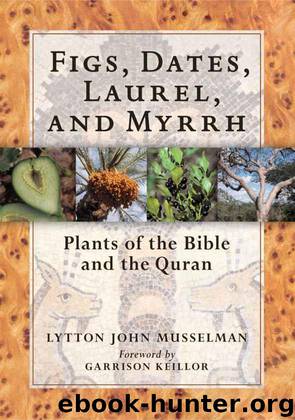Figs, Dates, Laurel, and Myrrh: Plants of the Bible and the Quran by Musselman Lytton John & Keillor Garrison

Author:Musselman, Lytton John & Keillor, Garrison [Musselman, Lytton John]
Language: eng
Format: mobi, epub
Publisher: Timber Press
Published: 2007-10-31T16:00:00+00:00
Vernal beauty in a field near Suweida, Syria, in March.
Two widespread and beautiful native wildflowers fit these criteria. The first, and in my opinion the more probable, is the crown anemone, Anemone coronaria. This plant flowers from late winter (February) to early spring (April) in the Middle East, in open, sunny areas. Flowers are crimson red with a black center, and leaves are finely dissected and close to the ground. In some populations, the color of the flower may be purple or pink and rarely white. During the dry summer, leaves die back. With the advent of winter rains, the rhizome sprouts new leaves.
The common poppy, Papaver rhoeas, flower of the field, is a second candidate. Flowers of this annual plant last only one day, in contrast to the crown anemone, and by afternoon the petals have fallen off. While crown anemone and poppy may be found growing together, poppy is more frequent in drier areas. For this reason, it is unlikely (but not impossible) that vegetation would be harvested. A third possibility is that Jesus is not referring to a specific plant but simply pointing out the beauty of creation and God’s care for it.
Download
Figs, Dates, Laurel, and Myrrh: Plants of the Bible and the Quran by Musselman Lytton John & Keillor Garrison.epub
This site does not store any files on its server. We only index and link to content provided by other sites. Please contact the content providers to delete copyright contents if any and email us, we'll remove relevant links or contents immediately.
The Five People You Meet in Heaven by Mitch Albom(3476)
The Secret Power of Speaking God's Word by Joyce Meyer(2978)
Real Sex by Lauren F. Winner(2968)
Name Book, The: Over 10,000 Names--Their Meanings, Origins, and Spiritual Significance by Astoria Dorothy(2940)
The Holy Spirit by Billy Graham(2894)
0041152001443424520 .pdf by Unknown(2785)
ESV Study Bible by Crossway(2733)
How The Mind Works by Steven Pinker(2729)
Ancient Worlds by Michael Scott(2627)
The Meaning of the Library by unknow(2506)
Churchill by Paul Johnson(2506)
The ESV Study Bible by Crossway Bibles(2502)
The Gnostic Gospels by Pagels Elaine(2472)
MOSES THE EGYPTIAN by Jan Assmann(2374)
Jesus by Paul Johnson(2310)
City of Stairs by Robert Jackson Bennett(2309)
The Complete Dead Sea Scrolls in English (7th Edition) (Penguin Classics) by Geza Vermes(2236)
Ancient Near Eastern Thought and the Old Testament by John H. Walton(2196)
The Nativity by Geza Vermes(2180)
